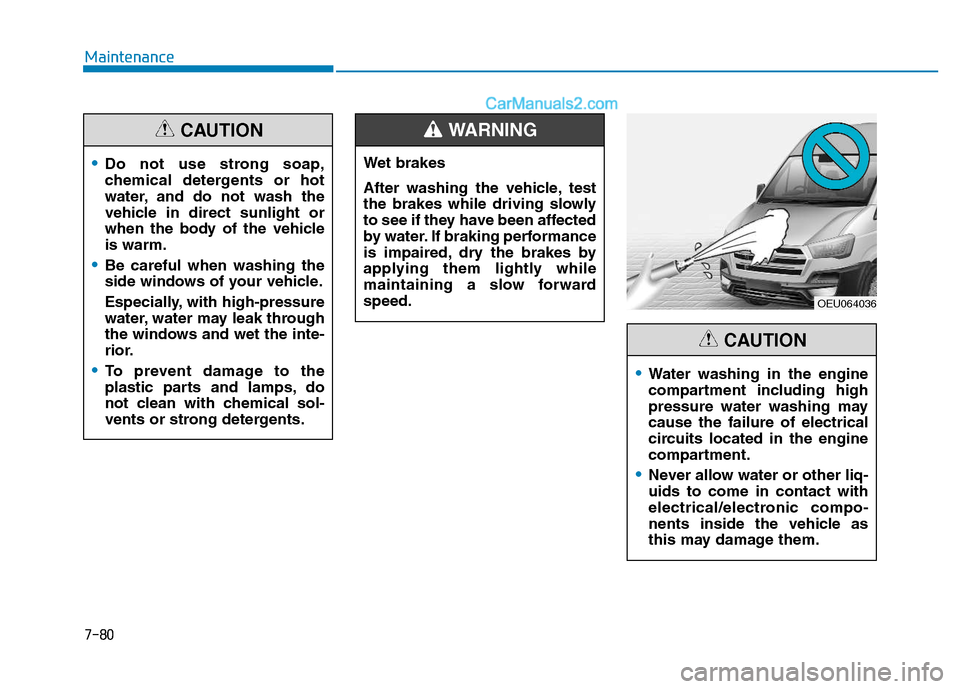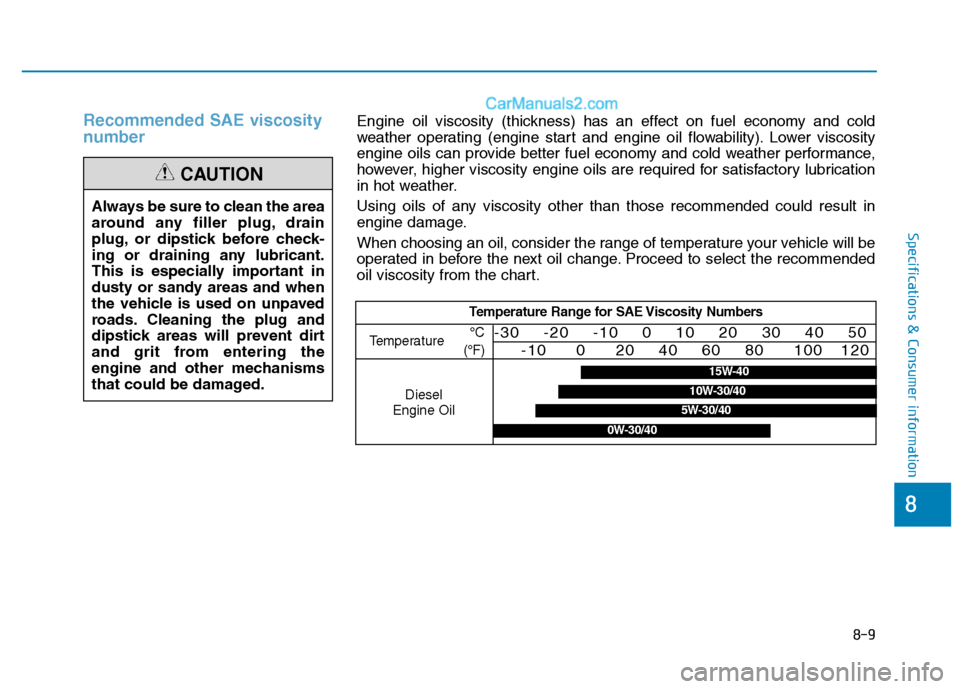2016 Hyundai H350 ESP
[x] Cancel search: ESPPage 434 of 473

7-71
7
Maintenance
2.The vehicle should be placed on aflat floor.
3.Draw vertical lines (Vertical lines passing through respective head
lamp centers) and a horizontal line
(Horizontal line passing throughcenter of head lamps) on thescreen.
4.With the head lamp and battery in normal condition, aim the head
lamps so the brightest portion falls
on the horizontal and vertical lines.
5-1. MFR type To aim the low/high beam left or
right, turn the screw (1) clockwise
or counterclockwise. To aim the
low/high beam up or down, turn the
screw (2) clockwise or counter-
clockwise. 5-2. Projection type
1) Low beam aiming
To aim the low beam left orright, turn the screw (3) clock-
wise or counterclockwise.
To aim the low beam up or
down, turn the screw (4) clock-
wise or counterclockwise.
2) High beam aiming High beam aiming is available
up direction or down.
To aim the high beam up or
down, turn the screw (5) clock-
wise or counterclockwise.Front fog light aiming
The front fog light can be aimed asthe same manner of the head lampsaiming.
With the front fog lights and battery
normal condition, aim the front fog
lights. To aim the front fog light up or
down, turn the bolt clockwise or
counterclockwise.
OEU074050
■■Fog light aiming
Page 443 of 473

7-80
Maintenance
Do not use strong soap,
chemical detergents or hot
water, and do not wash the
vehicle in direct sunlight or
when the body of the vehicleis warm.
Be careful when washing the
side windows of your vehicle.
Especially, with high-pressure
water, water may leak through
the windows and wet the inte-
rior.
To prevent damage to the
plastic parts and lamps, do
not clean with chemical sol-
vents or strong detergents.
CAUTION
Wet brakes
After washing the vehicle, test
the brakes while driving slowly
to see if they have been affected
by water. If braking performance
is impaired, dry the brakes by
applying them lightly while
maintaining a slow forwardspeed.
WARNING
OEU064036
Water washing in the engine
compartment including high
pressure water washing maycause the failure of electrical
circuits located in the engine
compartment.
Never allow water or other liq- uids to come in contact with
electrical/electronic compo-
nents inside the vehicle as
this may damage them.
CAUTION
Page 453 of 473

7-90
Maintenance
Diesel Particulate Filter (if equipped)
The Diesel Particulate Filter (DPF)
system removes the soot emitted
from the vehicle.
Unlike a disposable air filter, the DPF
system automatically burns (oxi-
dizes) and removes the accumulated
soot according to the driving condi-
tion. In other words, the active burn-
ing by engine control system and
high exhaust gas temperature
caused by normal/high driving condi-
tion burns and removes the accumu-lated soot.
However, if the vehicle continues to
be driven in short distance repeated-
ly or at low speed for a long time, the
accumulated soot may not be auto-
matically removed because of low
exhaust gas temperature. In this par-
ticular case, if the amount of soot is
out of detection limit, the DPF warn-
ing indicator ( ) will illuminate. In order to start the DPF regenera-
tion and to stop the DPF warning
lamp illuminating, drive the vehicle in
a safety driving circumstance with
more than 60km/h (37 mph) vehiclespeed or with more than secondgear engaged and 1500 ~ 2000
engine rpm for a certain time (for
about 25 minutes).
If the DPF warning indicator( )
continues to blink or "check emissionsystem" message comes on in the
cluster in spite of the above proce-
dure, we recommend that the system
be checked by an authorized
HYUNDAI dealer.
If you continue to drive with the indi-
cator light blinking for a long time, theDPF system can be damaged and
fuel consumption can be worsen.Diesel Fuel (if equipped with DPF) It is recommended to use the regulated automotive diesel
fuel for diesel vehicle equippedwith the DPF system.
If you use diesel fuel including high sulfur (more than 50 ppm
sulfur) and unspecified addi-
tives, it can cause the DPF sys-
tem to be damaged and whitesmoke can be emitted.
CAUTION
Page 462 of 473

8-9
8
Specifications & Consumer information
Recommended SAE viscosity
number
Always be sure to clean the area
around any filler plug, drain
plug, or dipstick before check-
ing or draining any lubricant.
This is especially important in
dusty or sandy areas and when
the vehicle is used on unpaved
roads. Cleaning the plug and
dipstick areas will prevent dirt
and grit from entering the
engine and other mechanisms
that could be damaged.
CAUTION
Temperature Range for SAE Viscosity Numbers
Temperature°C
(°F)-30 -20 -10 0 10 20 30 40 50 -10 0 20 40 60 80 100 120
Diesel
Engine Oil5W-30/40
15W-40
10W-30/40
0W-30/40
Engine oil viscosity (thickness) has an effect on fuel economy and cold
weather operating (engine start and engine oil flowability). Lower viscosity
engine oils can provide better fuel economy and cold weather performance,
however, higher viscosity engine oils are required for satisfactory lubrication
in hot weather.
Using oils of any viscosity other than those recommended could result in
engine damage.
When choosing an oil, consider the range of temperature your vehicle will be
operated in before the next oil change. Proceed to select the recommended
oil viscosity from the chart.
Page 470 of 473

I-5
Key positions ..................................................................5-5
Ignition switch position ...............................................5-5
Illuminated ignition switch ..........................................5-5
Starting the engine .......................................................5-6
Keys ................................................................................3-4 Immobilizer system .....................................................3-5
Key operations .............................................................3-4
Record your key number .............................................3-4
Lane departure warning system (LWDS) .....................5-37
Light bulbs ....................................................................7-67 Headlight and front fog light aiming (for Europe) ....7-70
Headlight, position light, turn signal light, front fog light bulb replacement ..............................7-68
High mounted stop light bulb replacement ...............7-78
Interior light bulb replacement ..................................7-78
License plate light bulb replacement .........................7-78
Rear combination light bulbs replacement ................7-75
Side marker lamp .......................................................7-75
Lighting.........................................................................3-95
Battery saver function ................................................3-95
Daytime running light..............................................3-101
Front fog light ..........................................................3-100
Headlight escort function...........................................3-96
Headlight leveling device ........................................3-101 Headlight welcome function ......................................3-96
High - beam operation ...............................................3-98
Lighting control .........................................................3-96
Rear fog light ...........................................................3-100
Turn signals and lane change signals ........................3-99
Load and speed capacity tires.........................................8-5
Locking differential ......................................................5-63
Maintenance services......................................................7-5 Engine compartment precautions (Diesel engine).......7-7
Owner's responsibility .................................................7-5
Owner maintenance precautions ..................................7-5
Manual transmission and rearaxle oil...........................7-31 Change the gear oil ....................................................7-31
Check and adding oil .................................................7-31
Manual transmission .....................................................5-14
Downshifting .............................................................5-16
Good driving practices...............................................5-17
Manual transmission operation..................................5-14
Using the clutch .........................................................5-16
Mid sliding door ...........................................................3-15 Child-protector mid sliding door lock .......................3-16
Opening/closing from the inside ...............................3-16
Opening/closing from the outside .............................3-15
Mirrors ..........................................................................3-39
Inside rearview mirror ...............................................3-39
Outside rearview mirror.............................................3-41
I
Index
K
L
M